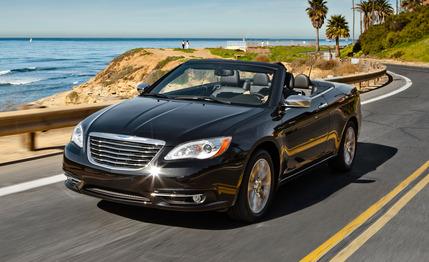
 First Drive Review
First Drive Review
Chrysler’s full-line extreme makeover has produced dramatic results for 2011, and the company literally did a number on its four-year-old Sebring sedan and convertible. The cars weren’t only thoroughly refreshed; they were also rechristened “200.” That shouldn’t fool anyone into thinking either 200 body style is all-new, as they retain the Sebring’s basic underpinnings, door skins, and roofline and convertible structure. But many people may be fooled nonetheless, since most everything else buyers see on the 200 replaces something that was uglier, cheaper, or both on the Sebring.
We provided a high-level overview of the convertible’s changes when Chrysler dropped official information and images recently. The one thing the press releases couldn’t tell us: How much better would the car be from behind the wheel? We were reasonably impressed with the 200 sedan after our first drive experience. Would the droptop take a similar leap toward decency? We took to the streets and sweeping mountain roads around San Diego, California, to find out.
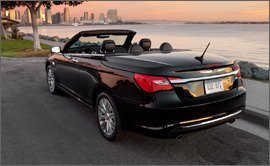

Styling Changes: More Effective than on the Sedan
Seeing it in the metal for the first time, we formed our initial reaction that the 200’s new front and rear styling improve the convertible’s appearance even more than the sedan’s, the latter still stuck with the Sebring’s awkward greenhouse and stubby trunk. Particularly with the top down, the convertible’s body—3.1 inches longer than the sedan’s—conveys the elegance of the first-generation Sebring convertible, sold from 1996 through 2000. Kudos to the design team for somehow making the Sebring’s scalloped door and quarter-panels look rather natural on the 200. New 17- and 18-inch wheel designs further support the car’s upward image trajectory, as do the Audi-esque LED accents in the front headlamps. And if it looks lower, that’s because it is, by 0.5 inch in front and 0.2 at the rear.
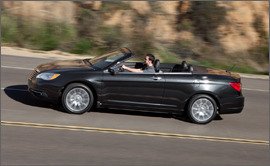

Comfortable Cabin
The interior’s transformation is nothing short of revolutionary, with occupants now surrounded by all-black or black-and-cream color schemes, top-stitched upholstery, and glitzy chrome trim. Most touch points on the door panels and console are now padded, effectively curing the Sebring’s chronic case of hard-plastic-itis. Two trims will be offered initially, starting with the $27,195 Touring model that includes cloth seats, a leather-wrapped multifunction steering wheel, classy LED-lit meters, and six-way power-operated seats for driver and passenger. The more luxurious Limited ($31,990) adds leather upholstery, heated front seats, remote start, Bluetooth connectivity, a powerful hard-drive-based Boston Acoustics sound system, and best of all, the 3.6-liter Pentastar V-6 (more on that later).
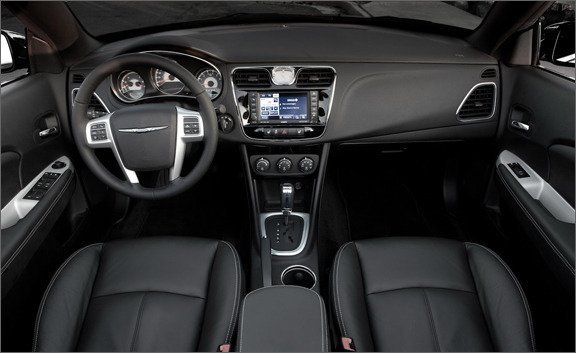

The 200 Limited continues to offer the choice of a fabric or steel roof. The latter commands a $1995 premium and delivers a 61-pound weight penalty. Both utilize the same folding mechanism, both raise and lower at a rather leisurely pace—27 seconds for the softtop, 30 for the hardtop—and both leave the same measly 6.6 cubic feet of trunk space with the top down. (For its part, Chrysler avers that two golf bags will fit.)


Still waiting in the wings is the range-topping 200 S convertible that, like the Limited, will come standard with the Pentastar V-6 and unique chrome-clad 18-inch wheels, a black chrome grille, and a smattering of sporty-looking exterior bits. Its interior will be filled with every available bell and whistle, as well as premium leathers in a unique, sport-flavored two-tone treatment. Sadly, the S model will bring no performance-enhancing bits. Pricing for the 200 S is yet to be announced.
Still Leisurely, but the Pentastar Shines
We were able to sample both of the 200’s available powerplants during our brief drive opportunity, starting with the base 2.4-liter four-cylinder with 173 hp and 166 lb-ft of torque. Predictably, the four-banger has a hard time pulling two tons of 200 with any sort of urgency, and the standard six-speed automatic transmission constantly shifts in the search for grunt. A $1795 upgrade on the Touring and standard on the Limited, the 3.6-liter Pentastar V-6 whips up 283 hp and 260 lb-ft of torque. The six’s robust, smooth power is far more in line with the 200’s other core competencies, with the bonus of EPA city fuel economy that’s higher by 1 mpg than the four-cylinder’s. (Chrysler estimates ratings of 19 mpg city/29 highway for the V-6 and 18/29 for the four.)
So long as we remained judicious with the throttle, the V-6 drive experience was effortless and relaxed, but flooring it found us doing a torque-steer tango with the steering wheel, which we didn’t experience as much in the 200 sedan. Not helping matters is the 200’s newly calibrated steering, which is reasonably precise and quick off-center but woefully overboosted, smothering any meaningful conversation between the driver and the front wheels. New designs for the front suspension cradle and mounts, as well as retuned dampers, help keep body motions in check during moderate cornering and braking, but make no mistake—like the Sebring, the 200 remains a smooth-riding cruiser decidedly calibrated for the leisure set.
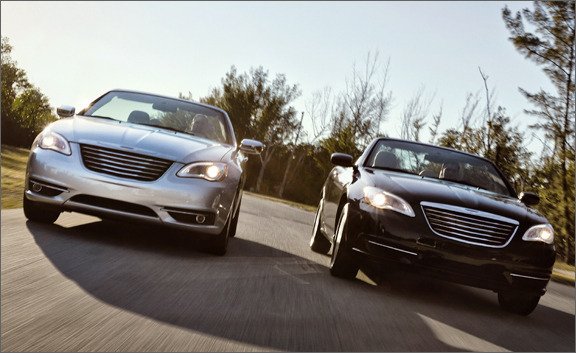

But it’s a much better cruiser. With the top raised, sound-deadening materials have made the 200 convertible nearly as quiet as the sedan, even on the highway. Top down, a degree of cockpit calm is attainable with the folding wind blocker (standard on Limited models) deployed over the rear seats. Unfortunately, the nav system in the 200 Limited loses points when fitted with the Garmin-based navigation system, whose graphics would seem sophomoric on a car costing $15,000, let alone one that commands twice that.
More Than Lipstick on a Pig
Were the 200 merely a reskinned Sebring, we would dismiss it as lipstick on a two-ton pig, hardly worthy of a new moniker. But although Chrysler could have gone further to make the 200 more fun to drive, the comprehensiveness of the revamp makes the new car far more appealing than its miserable predecessor. It’s now a place where four people can drink in a perfect day in comfort and competence, and that’s precisely the task every four-seat convertible should aspire to master.